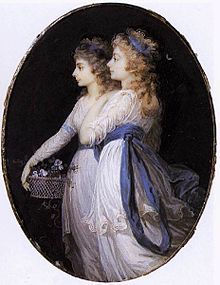Historical Ménage a Trois February 23, 2015
Author: Beach Combing | in : Contemporary, Modern , trackbackBeach has recently become fascinated by those who live a ménage a trois, leaving behind the conventional marriage of two and creating something like a marriage of three: a man lives with his wife and lover; a man lives with a gay policeman and his wife… etc etc Such a coupling (tripling) is difficult to pull off today, but in the past it must have been almost impossible to love in this way in the eyes of a hostile society. Yet often these triangles were created by society. One suspects that in a world where divorce was easier some of these relationships would never have developed. In fact, a striking number are a central dominant figure and two members of the opposite sex: one who has an atrophied sexual relationship with the central figure, and one who has, instead, a powerful sexual connection. A typical example, was Carl Jung’s bringing Toni Wolff into the house of his wife, the much put upon Emma Jung: Emma decided to allow Toni’s presence and the two got on relatively well, but Toni was not invited to Sunday family lunch, a small but important concession to propriety! One often, in fact, gets a sense of the tyranny of one of the three corners of the triangle: Jung loved to tell Emma that Toni was his ‘second wife’. When E. Nesbit, the children’s author, discovered that her husband, the caddish, Hubert Bland had got her best friend, Alice Hoatson, pregnant she was furious with both. Bland had Alice stay, though, as housekeeper and Alice remained there carrying his second child thirteen years later. Nesbit, a descent cove, treated both children as if there were her own, but there is no question that she was backed into a corner.
Sometimes the link between one part of the triangle and the other two points has become so weak that it perhaps should not be counted as a ménage a trois at all: William Hamilton may have tolerated his wife’s infidelities with Lord Nelson, but the three were not in the habit of taking tea together; though Hamilton, a gentleman, left Nelson a small enamel portrait of Emma at his death and the three lived together in a very large country house. Of course, the constant proximity of even sexual rivals ushered in friendship in some cases. The most striking example of this is the relationship between the great English novelist, E.M.Forster and May Buckingham, the wife of the bisexual policeman, Bob, with whom Forster had thirty odd years of sex. Forster eventually became friends with May, particularly after she had to spend time away in a TB asylum. There is a sense in which May was, in the end, at least as important to him as Bob: she claimed to have replaced Forster’s difficult mother. It was May who, in the end, defended Forster’s right to die in their home to her husband (who had become anxious about some of Forster’s revelations) and Forster himself passed on holding Mary’s hand. Another case where the triangle settled down into a series of surprisingly equal relationships was the one between Lenin, the beautiful Inessa Armand and Lenin’s long suffering wife Nadya. As one of Lenin’s more recent biographers has put it this was that rarest thing, a love triangle where every one behaved decently. The two women, both of whom were far better than the moustache at the centre of their life, settled down into a knitting-circle friendship and Nadya moved into her mother’s bedroom.
There are some very rare cases of the ménage a trois where every line of the triangle was sexually energized. A rather tawdry example is the affair between Henry Miller and Anais Nin and June Miller. Despite the frankest diary imaginable it is, though, difficult to understand quite what happened and when. More interesting, in so many ways is the curious affair between the Duke of Devonshire, his wife Georgina and Elizabeth Hervey Forster (both pictured above). ‘Bess’ was invited by Georgina to come and live with she and the Duke, but Bess became the lover of the Duke and possibly the lover of Georgina, certainly the two women enjoyed a passionate friendship through many years of shared pregnancies.
Other instances of historical ménage a trois: drbeachcombing AT yahoo DOT com
24 Feb 2015: Invisible writes: ‘The composer Ralph Vaughan Williams, despite his rumpled, avuncular appearance, lived in a menage a trois with his wife Adeline, crippled by terrible arthritis, and his “assistant,” the poet Ursula Wood, whom he married after Adeline’s death. Wood told of an evening in 1944 during a Nazi air raid, when the three lay together in Williams’ residence in Surrey: the composer in one bed, his wife in another and the mistress between the two on a mattress on the floor—holding their hands as they all listened to the planes overhead.’ Thanks Invisible!
14 mar 2015: Bruce T giving us the French connection. ‘Arthur Rimbaud, Paul Verlaine, and Verlaine’s wife, Mathilde. Verlaine became so enamored of the young Rimbaud, he began to stalk Rimbaud after their affair whimpered out. Verlaine ended up shooting Rimbaud in the wrist during a drunken rage. Verlaine goes to prison, Rimbaud goes first to the Yemen,and then Harrar, Ethiopia living out a short but a prosperous life as coffee merchant. Verlaine? He converted to Catholicism in prison, then drank and drugged himself to death over the next 20 years. Mathilde grabbed her newborn baby, and got out early in the first year of the mess. Of her fate, I know nothing.’ thanks Bruce



